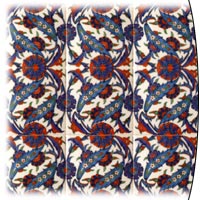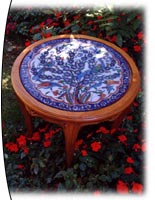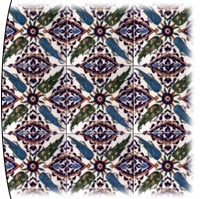Revival of İznik Tiles After 300 Years
 İznik is located on the banks of the lake of the same name in the province of Bursa in the north-western part of Anatolia. In antiquity it lay within the borders of the Bithynian region. One legend says that the town was established on the return of the God Dionysus from India. According to another legend, İznik was colonized by the soldiers who escorted Alexander the Great (356-323 B.C.) during his conquests.
İznik is located on the banks of the lake of the same name in the province of Bursa in the north-western part of Anatolia. In antiquity it lay within the borders of the Bithynian region. One legend says that the town was established on the return of the God Dionysus from India. According to another legend, İznik was colonized by the soldiers who escorted Alexander the Great (356-323 B.C.) during his conquests.
When Antigonas Monophthalmus founded the city in 316 B.C., there was already a settlement of the Bottiaei people here, called Elikore, but Antigonas called the town Antigoneia after himself. After the battle of Ipsus (301 B.C.), one of Alexander’s generals, Lysimachus (360-281 B.C.), took the city and named it after his wife Nikaia, the daughter of the Macedonian leader, Antipatros. Throughout the centuries the name Nikaia went through slight phonetic changes, becoming first Nicea and eventually İznik in Turkish times.
 In the course of its history from 316 B.C. to the present-day, İznik presents a picture of a city which has undergone great cultural and architectural changes. In the true sense of the word, İznik is an archaeological and historical art laboratory of the Romans, Byzantines, Seljuk and Ottoman Turks.
In the course of its history from 316 B.C. to the present-day, İznik presents a picture of a city which has undergone great cultural and architectural changes. In the true sense of the word, İznik is an archaeological and historical art laboratory of the Romans, Byzantines, Seljuk and Ottoman Turks.
Following the recent excavations of İznik kilns on the site, Prof. Aslanapa and Prof. Altun have clearly observed that the Ottoman ceramics in İznik had a Seljuk background. The latest research and analysis have revealed that the white pasted hard ceramic consists of the same material as the soft porcelain used in the Ottoman Period. At first, blue and white were the prevailing colors in the pots and wall tiles in this category. During the 16th century, the turquoise was introduced. The embossed red of the wall tiles of the mihrab of Süleymaniye Mosque (1555) marks the peak of Ottoman tiles and ceramics. During the Ottoman era, the İznik tiles and pottery were exported to other countries via the Island of Rhodes, which was then under Turkish rule.
 Evliya Çelebi, the famous Turkish traveller, mentions the existence of 300 workshops in İznik during the 17th century. This number, also justified by the excavations, gives us an idea of the importance of tile production in this town. Various reasons have been put forward with regard to the decline of tile production in İznik. The most widely accepted theory is that the demand from Istanbul for the use of these tiles in major public buildings such as mosques and palaces had fallen during the period of decline of the empire. In the beginning of the 20th century, the population of İznik was composed of Turks as well as small ethnic minorities such as Greek and Armenians involved in farming and silk production.
Evliya Çelebi, the famous Turkish traveller, mentions the existence of 300 workshops in İznik during the 17th century. This number, also justified by the excavations, gives us an idea of the importance of tile production in this town. Various reasons have been put forward with regard to the decline of tile production in İznik. The most widely accepted theory is that the demand from Istanbul for the use of these tiles in major public buildings such as mosques and palaces had fallen during the period of decline of the empire. In the beginning of the 20th century, the population of İznik was composed of Turks as well as small ethnic minorities such as Greek and Armenians involved in farming and silk production.
 During the Turkish war of Independence, İznik went through turbulent times. The town was invaded by Greeks in September 1920, and towards the final stages of the war it was burnt to the ground by the defeated invaders and the inhabitants had to flee. With the declaration of the Turkish Republic, İznik became home for an influx of Turkish immigrants from Greece and Thrace.
During the Turkish war of Independence, İznik went through turbulent times. The town was invaded by Greeks in September 1920, and towards the final stages of the war it was burnt to the ground by the defeated invaders and the inhabitants had to flee. With the declaration of the Turkish Republic, İznik became home for an influx of Turkish immigrants from Greece and Thrace.